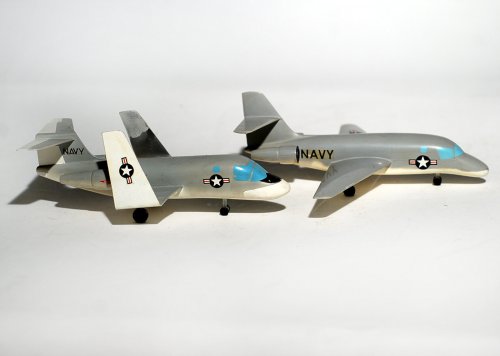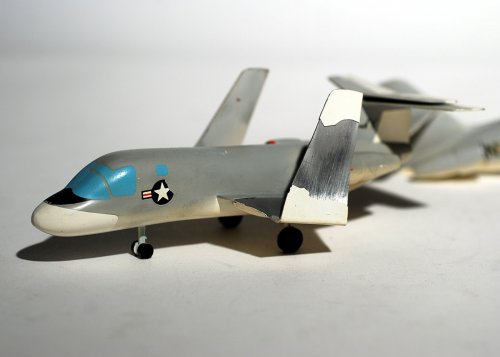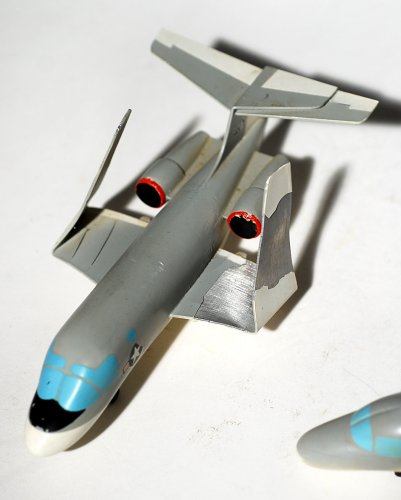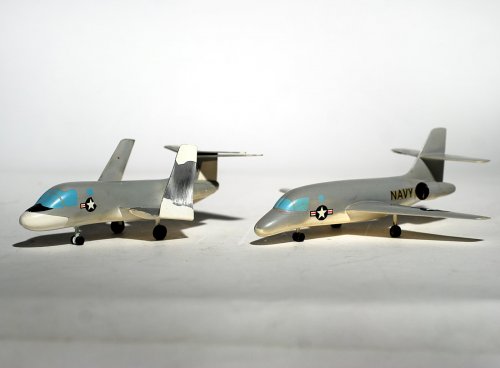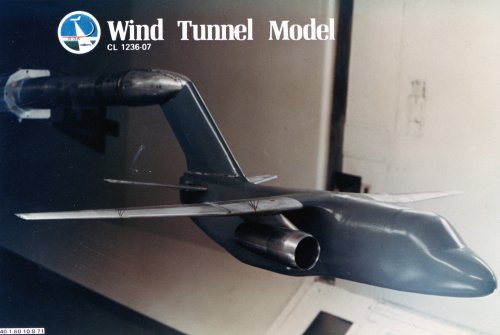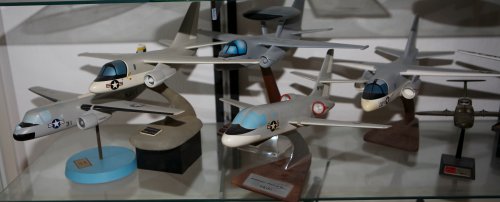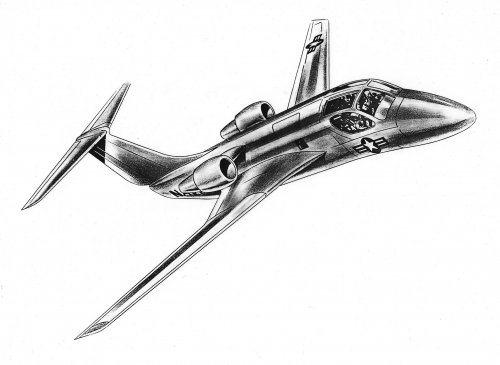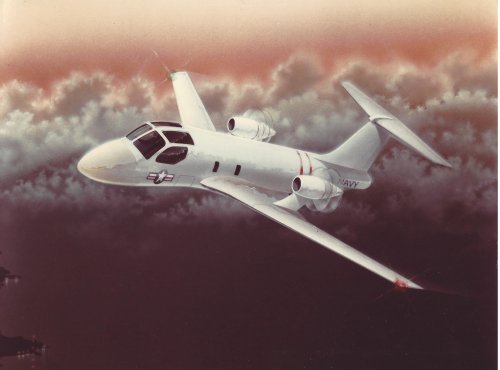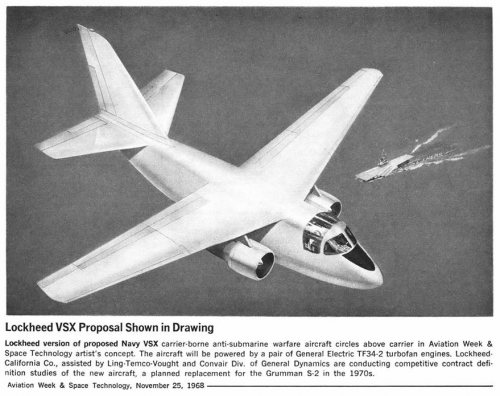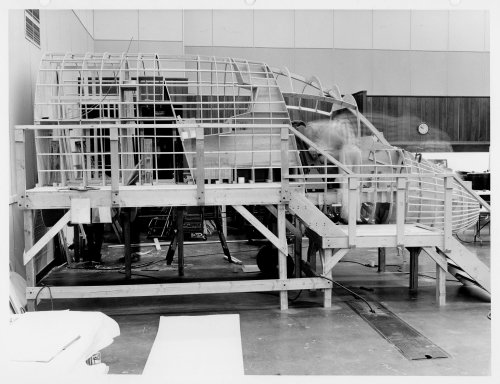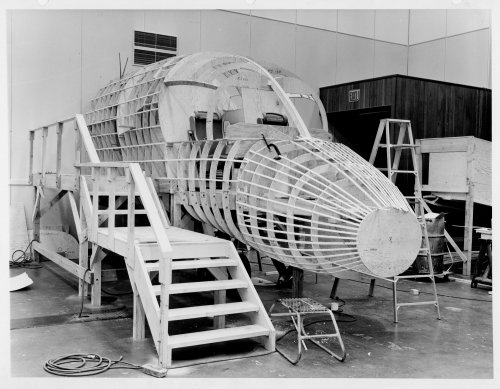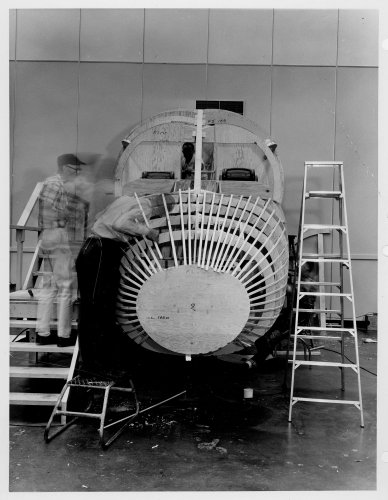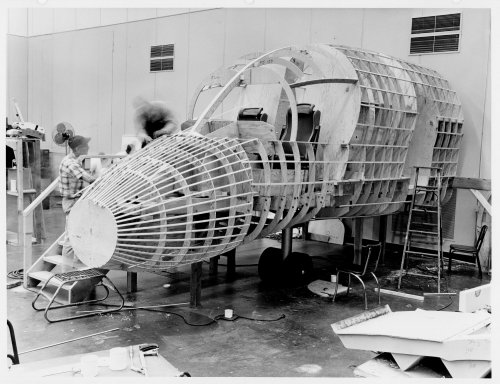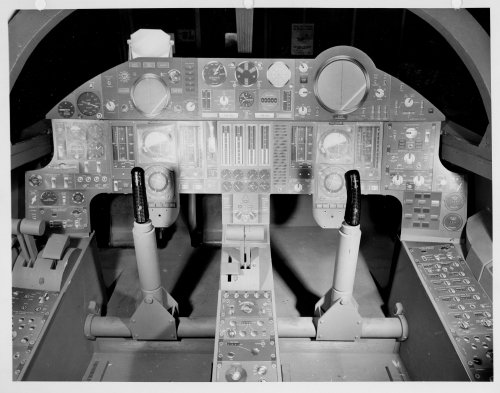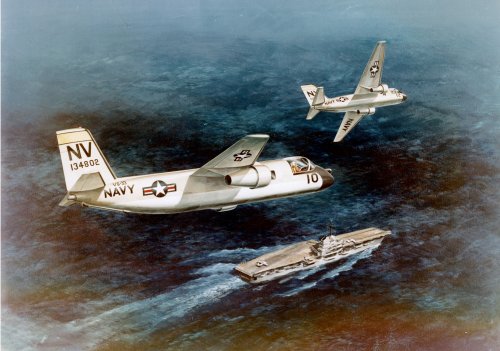You are using an out of date browser. It may not display this or other websites correctly.
You should upgrade or use an alternative browser.
You should upgrade or use an alternative browser.
VSX / TS-160: Alternatives to the S-3 Viking
- Thread starter Pioneer
- Start date
- Joined
- 11 March 2006
- Messages
- 8,625
- Reaction score
- 3,797
gral_rj said:Does the top of the vertical stabilizer fold?
Most probably explanation, as the hinge lines of the double wing-fold are shown
with the same lines.
McDonnell Douglas inhouse-built VSX concept models found on eBay.
Source:
Source:
Attachments
Can anyone identify one of the concept models as the McDonnell Douglas MD-893 VSX proposal?
- Joined
- 31 May 2009
- Messages
- 1,154
- Reaction score
- 672
Triton said:Can anyone identify one of the concept models as the McDonnell Douglas MD-893 VSX proposal?
Both these spotting models appear to have quite different profiles. I think we are looking at (Qty.1) each of the McAir Model 201 and the McDonnell Douglas MD-893. These photos deserve to be moved to the regular VSX topic, now that the eBay auction is over.
Congratulations, circle-5?
- Joined
- 5 May 2007
- Messages
- 351
- Reaction score
- 406
Just posted at Flickr by the San Diego Air & Space Museum (SDASM) (albeit at a maddening low resolution) a photo of an exposition display board touting Convair's VS(X) proposal (Convair Model 21), featuring one of the illustrations posted by Orionblamblam earlier in this thread (Interestingly with differing tail art and Modex number!), as well as a photos of the mock-up's cockpit and wind tunnel testing.
http://www.flickr.com/photos/sdasmarchives/23696780056/

http://www.flickr.com/photos/sdasmarchives/23696780056/

- Joined
- 13 June 2007
- Messages
- 2,173
- Reaction score
- 3,087
Greetings All -
From the SDASM Archives, a Lockheed wind tunnel model for the S-3 design. Interesting details and to me shows again the strength of Vought's expertise in the results of the Lockheed S-3 design as produced.
Enjoy the Day! Mark
From the SDASM Archives, a Lockheed wind tunnel model for the S-3 design. Interesting details and to me shows again the strength of Vought's expertise in the results of the Lockheed S-3 design as produced.
Enjoy the Day! Mark
Attachments
- Joined
- 5 May 2007
- Messages
- 351
- Reaction score
- 406
San Diego Air & Space Museum (SDASM) Flickr photostream recently added some Convair VSX-related images. Here are a couple of examples.
Convair VSX Cockpit Simulator
http://www.flickr.com/photos/sdasmarchives/30093445280/

Convair VSX Antenna Model
http://www.flickr.com/photos/sdasmarchives/30093116210/

Convair VSX Cockpit Simulator
http://www.flickr.com/photos/sdasmarchives/30093445280/

Convair VSX Antenna Model
http://www.flickr.com/photos/sdasmarchives/30093116210/

- Joined
- 13 June 2007
- Messages
- 2,173
- Reaction score
- 3,087
Most excellent - thanks! Mark
- Joined
- 21 May 2006
- Messages
- 3,002
- Reaction score
- 2,273
G'day gents
Found this interesting information pertaining to the Specific Operational Requirement for the VSX at http://www.lockheedmartin.com/us/news/features/2016/C1S3VikingPilot.html
Regards
Pioneer
Found this interesting information pertaining to the Specific Operational Requirement for the VSX at http://www.lockheedmartin.com/us/news/features/2016/C1S3VikingPilot.html
This was the genesis of the Specific Operational Requirement, or SOR, for the VSX program that was released to industry in late late1966. A formal request for proposal was answered by two industry teams in April 1968. The team of Lockheed, LTV, Sperry Univac and GE competed against Grumman, IBM, and General Dynamics. Final bids were submitted in December 1968 and on 4 August 1969, the Lockheed team was declared the winner.
One of the unique and ultimately successful features of the S-3A contract was that it was a fixed price development contract incorporating a target price as well as ceiling. It was milestone based, with fixed dates for each of some eighteen major program milestones, one of which was the first flight date of the first prototype aircraft. The production contracts were also fixed price which significantly overlapped both the development and production lots of aircraft.
To the amazement of many people in both industry and the military, the Lockheed team met or beat every single milestone in the contract and came in below the ceiling price for every phase of the development and production contract lots. Crew training started on schedule and the program met its initial operational capability, or IOC, date with the aircraft carrier deployment on schedule.
Reaching these milestones was no small task considering virtually every element of the S-3A was a new development and included the following requirements:
Completely new airframe
Completely new and first high bypass ratio turbofan engine in this class
First application of an airborne central digital computer and fully integrated avionics system
First sequenced, four-crew ejection system with zero/zero to 450 knot capability
Single engine bolter at max carrier landing weight with gear and flaps down
Fully Automatic Carrier Landing System, or ALCS, with autothrottle delivered at IOC
Inflight refueling
Ability to carry and deploy sixty search stores
Two internal bomb bays and two wing stations capable of carrying conventional bombs, torpedoes, depth charges, and nuclear weapons
Meet MIL-SPEC Flying Qualities requirements with no stability augmentation throughout its entire flight envelope from 90-450 KIAS at sea level
A fully automatic or electrically selectable manual back up, or EFCS, flight control system
Ability to descend from 30,000 feet to the surface in two minutes
A ground and in-flight operational auxiliary power unit for self-contained operations and engine starts
The approach speed of an A-6 with the sink rate design of the A-7 attack aircraft
Foldable wings and vertical tail to fit an <i>Essex</i>-class aircraft carrier
First non-paper trace system of analyzing submarine acoustic signatures on a CRT projection
Eight YS-3A prototypes built. John Christianson and I made the first flight of the first prototype (Navy Bureau Number 157992) on 21 January 1972. The aircraft was trucked from Burbank, California, where it was built. The ninety-minute flight came from Air Force Plant 42 in nearby Palmdale. Three months later, in April 1972, the Navy ordered the first thirteen production aircraft.
The first operational delivery took place to VS-41 in NAS North Island, California, in February 1974; less than two years after the first flight of the first prototype and only four-and-one-half years after the Lockheed team had been declared winners in the VSX competition. A total of 187 aircraft were built and the last was delivered to NAS North Island in August 1978.
Regards
Pioneer
- Joined
- 21 May 2006
- Messages
- 3,002
- Reaction score
- 2,273
Just stumbled across this, which I thought very interesting and relevant:
Source: http://www.whatifmodellers.com/index.php/topic,20902.15.html
Regards
Pioneer
Article entitled "Grumman's Guardian", by Corwin H. Meyer. "Corky" Meyer was a Grumman test pilot from the 40s to the 70s, and later went on to work the business end of the company. I've been reading his stuff for a few years, and he knows what he's talking about. The article details the development of the AF Guardian, Grumman's first purpose-built ASW aircraft. He traces the program from its origins in modified TBF Avengers, to the aircraft's eventual replacement by the S2F Tracker. An epilogue to the story talks a little about the VSX proposal.
"Arrogance ends the Grumman ASW monopoly
After building 11,489 Anti-Submarine Warfare Avengers, Guardians and its follow-on S2F twin-engine Trackers, Grumman lost the next ASW carrier aircraft competition on August 1, 1969, to the Lockheed S-3A Viking. Although I was no longer director of business development, I was sent by the Grumman president to Washington to find out why. A former Navy friend allowed me to read the decision paperwork. It stated, "The Navy expected Grumman to win after their continuous 28 years of supplying the Navy with excellent ASW aircraft.
Because of Grumman's pompous attitude expressed in their very skimpy proposal, they were rated 25th in a five-company competition!" I went home and read our proposal. It was a "Send us the money and we will make you the next ASW aircraft" - a real ego-trip dud by Grumman. This team from engineering was never allowed to do a preliminary design again."
Source: http://www.whatifmodellers.com/index.php/topic,20902.15.html
Regards
Pioneer
- Joined
- 29 January 2008
- Messages
- 916
- Reaction score
- 2,054
- Joined
- 13 June 2007
- Messages
- 2,173
- Reaction score
- 3,087
Would agree with you RAP though I had not seen a drawing/art with the unducted fan before.
Thanks! Mark
Thanks! Mark
- Joined
- 13 June 2007
- Messages
- 2,173
- Reaction score
- 3,087
Good Day All -
I went to an estate auction for a retired McDonnell Douglas engineer and bought a number of interesting drawings, photos and documents. The attached photos are of the mock up for the forward fuselage of the Model 201 which was McDonnell's entry for the VSX proposal. The last photo of the instrument panel is not from the same photo series and frankly, the date stamp on the back of the photo is wrong or it is for something else entirely. I cannot think of any twin engine design/proposal in the 1981 timeframe. I don't think the canopy frame arch quite matches up either though a camera lens may distort that to some extent. Open to any suggestions....
Enjoy the Day! Mark
I went to an estate auction for a retired McDonnell Douglas engineer and bought a number of interesting drawings, photos and documents. The attached photos are of the mock up for the forward fuselage of the Model 201 which was McDonnell's entry for the VSX proposal. The last photo of the instrument panel is not from the same photo series and frankly, the date stamp on the back of the photo is wrong or it is for something else entirely. I cannot think of any twin engine design/proposal in the 1981 timeframe. I don't think the canopy frame arch quite matches up either though a camera lens may distort that to some extent. Open to any suggestions....
Enjoy the Day! Mark
Attachments
- Joined
- 3 June 2006
- Messages
- 3,094
- Reaction score
- 3,956
Thanks, Mark. B)
"CAD and Photoshop killed the mockup star." :-\sferrin said:Does anybody even build mockups anymore? :'(
- Joined
- 2 August 2006
- Messages
- 3,255
- Reaction score
- 1,527
sferrin said:Does anybody even build mockups anymore? :'(
Yes, Sikorsky did with the Raider, although the production version was markedly different. Although, I also get what you're saying, and I now think when it's done, it's done more for marketing than engineering.
- Joined
- 3 June 2011
- Messages
- 18,331
- Reaction score
- 12,213
Sundog said:sferrin said:Does anybody even build mockups anymore? :'(
Yes, Sikorsky did with the Raider, although the production version was markedly different. Although, I also get what you're saying, and I now think when it's done, it's done more for marketing than engineering.
Come to think of it, didn't Bell with their V-280?
- Joined
- 4 May 2008
- Messages
- 2,439
- Reaction score
- 762
I think Sundog is right, nowadays it's probably more of a marketing exercise. The goal being to get a cool looking piece of plywood fiberglass at Quad-A to get a general to sit on. I doubt those are bona fide engineering mockups, intended as tools useful for making design decisions. I too decry the extinction of the mockup, although i'm sure CATIA people will say digital mockups are just as good if not better.
- Joined
- 13 June 2007
- Messages
- 2,173
- Reaction score
- 3,087
I'm guessing someone has already gone VR for a aircraft walk through....
Enjoy the Day! Mark
Enjoy the Day! Mark
- Joined
- 13 June 2007
- Messages
- 2,173
- Reaction score
- 3,087
DarkFriday
Hoovers Rule
- Joined
- 16 July 2020
- Messages
- 2
- Reaction score
- 5
Fantastic thread.
Nice to be here.
Nice to be here.
Hope that I am not 'too late to the party' on this thread. Great insights here, thanks to all who have posted.
I have been contracted by Schiffer Publishing to write the S-3 Viking chapter of their "Legends of Warfare" series. While I am decidedly an A-7 bubba, I guess there is enough commonality and shared DNA with the War Hoover for me to give it its due.
Would love to get high-res scans of these VSX proposals to include in my book. Of course, all contributions would be credited. If any of you have high-res scans of your previous posts (or any other relevant items), feel free to send them on! Address is a7ciia@gmail.com. Thanks in advance.
- Mat "Irish" Garretson
Executive Director
The A-7 Corsair II Association
I have been contracted by Schiffer Publishing to write the S-3 Viking chapter of their "Legends of Warfare" series. While I am decidedly an A-7 bubba, I guess there is enough commonality and shared DNA with the War Hoover for me to give it its due.
Would love to get high-res scans of these VSX proposals to include in my book. Of course, all contributions would be credited. If any of you have high-res scans of your previous posts (or any other relevant items), feel free to send them on! Address is a7ciia@gmail.com. Thanks in advance.
- Mat "Irish" Garretson
Executive Director
The A-7 Corsair II Association
- Joined
- 27 December 2005
- Messages
- 17,749
- Reaction score
- 26,376
Hope that I am not 'too late to the party' on this thread. Great insights here, thanks to all who have posted.
I have been contracted by Schiffer Publishing to write the S-3 Viking chapter of their "Legends of Warfare" series. While I am decidedly an A-7 bubba, I guess there is enough commonality and shared DNA with the War Hoover for me to give it its due.
Would love to get high-res scans of these VSX proposals to include in my book. Of course, all contributions would be credited. If any of you have high-res scans of your previous posts (or any other relevant items), feel free to send them on! Address is a7ciia@gmail.com. Thanks in advance.
- Mat "Irish" Garretson
Executive Director
The A-7 Corsair II Association
The SDASM Photos can be obtained directly from SDASM at a cost.
Most of the other pictures of interest were posted by @Mark Nankivil who is a pretty helpful guy.
- Joined
- 3 June 2006
- Messages
- 3,094
- Reaction score
- 3,956
Convair Model 21.
View: https://flic.kr/p/2kGZxS5
View: https://flic.kr/p/2kGZy2P
Mislabelled as Lockheed S-3 Viking at SDASM Flickr Archives.
View: https://flic.kr/p/2kGZxS5
View: https://flic.kr/p/2kGZy2P
Mislabelled as Lockheed S-3 Viking at SDASM Flickr Archives.
Last edited:
- Joined
- 27 December 2005
- Messages
- 17,749
- Reaction score
- 26,376
General Dynamics News 17 Jan 1968Planning Design For New Plane
Convair division of General Dynamics will be one of five major aircraft manufacturers competing for a Contract Definition contract on the Navy's new carrier-based anti-submarine warfare system, designated the VSX.
Request for Proposal for Contract Definition on the VSX was released by the Navy Air Systems Command, contracting agency, at the year's end, Dec. 29, 1967. Proposals must be submitted by mid-April of this year and award of the Contract Definition contract is expected by August of companies who will then compete for development and production.
The VSX is a follow-on to the S-2E Tracker and should be in service n the 1970s as a carrier-based airborne anti-submarine warfare (AWS) system. It will carry a large payload of sophisticated avionics including digital data processing equipment.
A Convair team of highly-qualified technical personnel, headed by Earl W. Boteler as program director, has been directing its efforts to study of the Navy's requirements and to preliminary design concepts of the new aircraft over the last two years in preparation for the beginning of the bid competition.
In order to meet the challenge the program presents, Convair has drawn on the anti-submarine warfare knowledge and skill of the entire General Dynamics Corporation, specifically Electric Boat and Pomona divisions and Stromberg-Carlson. According to Boteler, Convair has been able to assemble from among its own employees a group with extensive carrier experience from both the operational and industrial design aspects.
Working with Convair as part of the ASW avionic team is General Electric Co. in the central processing and non-acoustic sensors subsystems, Sanders Associates in the acoustic subsystem, and TRW Systems Group in the navigation subsystem. Each of these companies has established offices at Convair's Lindbergh Field plant, where the VSX project is headquartered.
- Joined
- 21 May 2006
- Messages
- 3,002
- Reaction score
- 2,273
Just a side snippet to the S-3 Viking story, somewhat ironic in my opinion, when the USN more than ever needs such capability....
Regards
Pioneer

 www.thedrive.com
www.thedrive.com
Regards
Pioneer

The Last Airworthy S-3B Viking Is Set To Fly Off Into The Sunset
NASA's retirement of its S-3B aircraft means the long, storied career of the famed submarine hunter has finally come to an end.
- Joined
- 29 September 2006
- Messages
- 1,791
- Reaction score
- 1,357
This iteration of the Model 21 seems quite different from the others in the thread, most recently seen in Mark Nankivil's post #69. The wingroots have circular 'shoulders' sticking out, and traling from the aft of the wing roots are substantial structures which I would hesitate to describe as fairings.Convair Model 21.
View: https://flic.kr/p/2kGZxS5
View: https://flic.kr/p/2kGZy2P
Mislabelled as Lockheed S-3 Viking at SDASM Flickr Archives.
Do we have any infomation on these strange wing/fuselage structures?
- Joined
- 19 February 2007
- Messages
- 1,438
- Reaction score
- 2,676
IIRC, Convair planned different fuselages for ASW and COD variants. To enable this, the common main landing gear had very long struts, hinged at the under wing area and retracting up and aft into the fuselage fairings. (Somewhat like the German P.1101arrangement.) I do not know the reasoning for the leading edge extensions.
Planejunk1944
ACCESS: Restricted
- Joined
- 22 June 2022
- Messages
- 15
- Reaction score
- 61
Pardon the necromancy, but I have always been a bit confused concerning the Convair division after the merger with General Dynamics. Were they still a seperate aircraft designing entity from GD Fort Worth or is "Convair" just a vestigial name for the Fort Worth division?
US Navy`s ‘Carrier-Based ASW Aircraft Experimental’ (VSX) Program
Although they are being phased out of service (long before their time!) the US Navy’s Lockheed S-3 Viking ASW aircraft was one of the most advanced and compact aircraft of its type and role ever built.
(Note- One must remember that LTV (Vought) had a lot to do with making the Viking what it was and so successful, with Lockheed sorting LTV`s input as prim contractor for its great knowledge and experience in designing carrier based aircraft)
But the Lockheed S-3 Viking’s history stemmed from a 1968 US Navy Request for Proposal (RfP) for an advanced Carrier-Based ASW aircraft Experimental (VSX).
But who knows of the other four designs that were submitted to the Request for Proposal, by-
• Grumman
• McDonnell Douglas
• General Dynamics (Model 21)
• North American – Rockwell
Does anyone have any information, design designations, pictures, artwork /drawings of the designs submitted
Regards
Planejunk1944
ACCESS: Restricted
- Joined
- 22 June 2022
- Messages
- 15
- Reaction score
- 61
This collection of photos are from three booklets I have and one drafting drawing (67” C 36”) the booklets are volumes 14 (2 one early, one later) and 15. I just found them last week in the Convair file cabinets. Could be more booklets in the cabinets. 75 cabinets and about 100 file boxes. Most stuff in all them are boring technical stuff or related to the CV-880 and CV-990 that belong to my son. He has an awesome aircraft collection, a lot are cockpit sections. Anyway I’ll list as many photos as allowed. Love to help.
Attachments
-
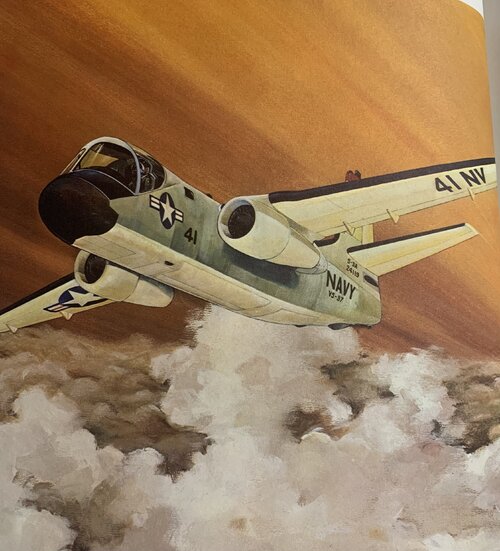 D7B5B4FC-B798-408A-9F25-89C0D7AE838C.jpeg2.9 MB · Views: 248
D7B5B4FC-B798-408A-9F25-89C0D7AE838C.jpeg2.9 MB · Views: 248 -
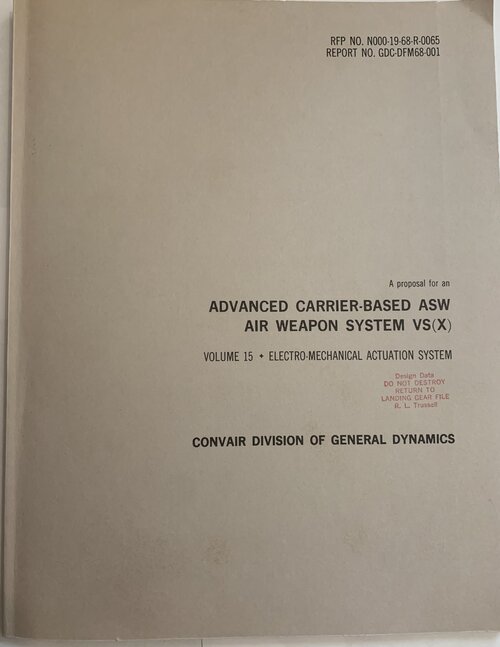 BF10EA56-E4EA-46F5-BC24-18B1251D4966.jpeg2 MB · Views: 225
BF10EA56-E4EA-46F5-BC24-18B1251D4966.jpeg2 MB · Views: 225 -
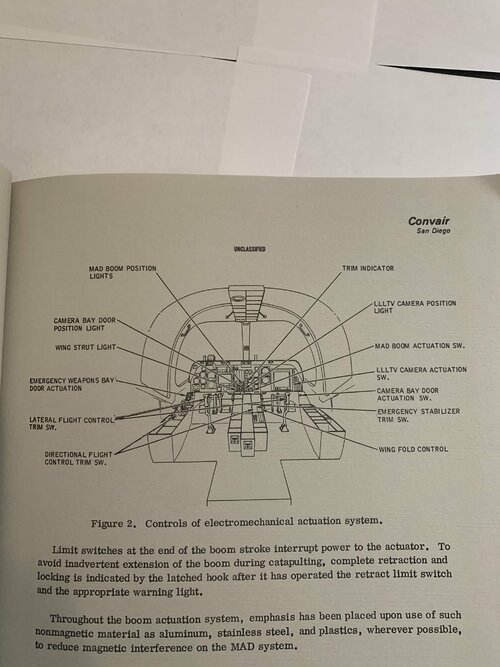 3B371A66-4B5B-4288-953C-72B8BABB7DD7.jpeg1.2 MB · Views: 189
3B371A66-4B5B-4288-953C-72B8BABB7DD7.jpeg1.2 MB · Views: 189 -
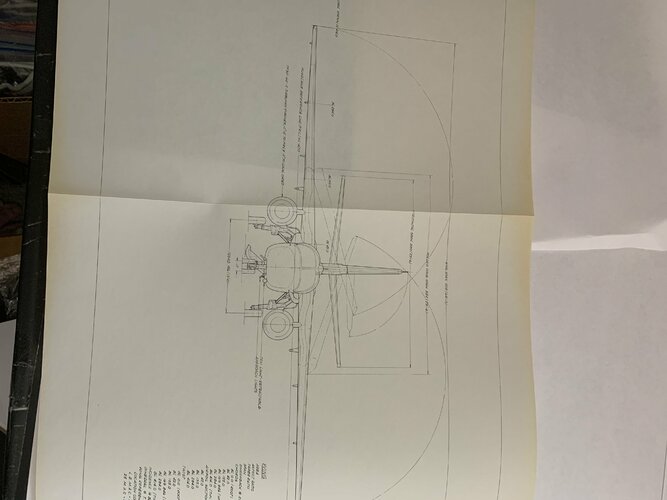 B5CAC908-35B5-468C-8748-D948579F2B58.jpeg985.4 KB · Views: 184
B5CAC908-35B5-468C-8748-D948579F2B58.jpeg985.4 KB · Views: 184 -
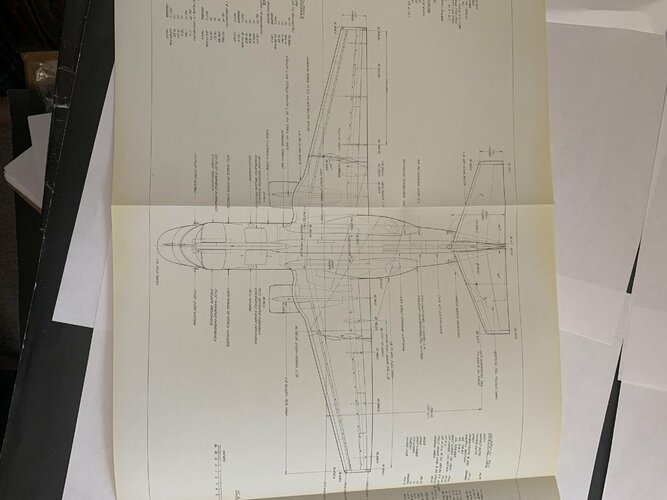 BA88C2F9-DFC1-4DE7-A14B-F75BB5B42B9D.jpeg1.1 MB · Views: 180
BA88C2F9-DFC1-4DE7-A14B-F75BB5B42B9D.jpeg1.1 MB · Views: 180 -
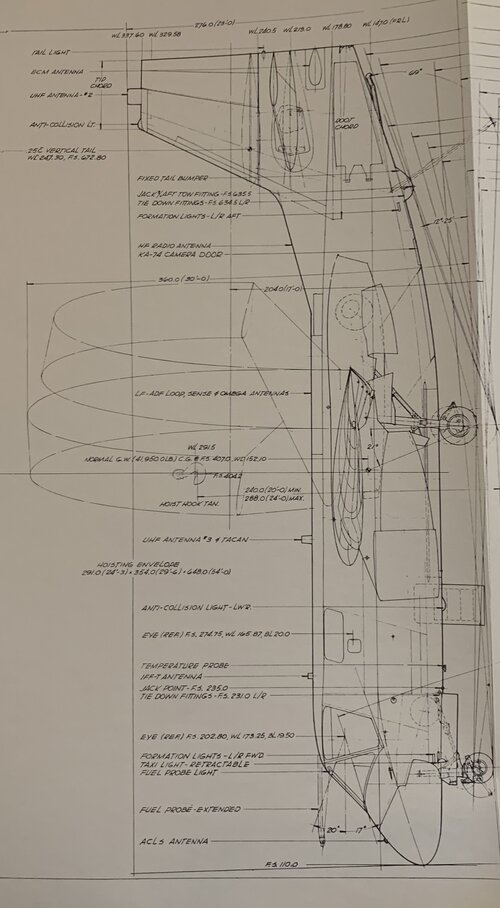 9D81CAA7-497E-418C-BCC1-6DA2B1384391.jpeg1.1 MB · Views: 188
9D81CAA7-497E-418C-BCC1-6DA2B1384391.jpeg1.1 MB · Views: 188 -
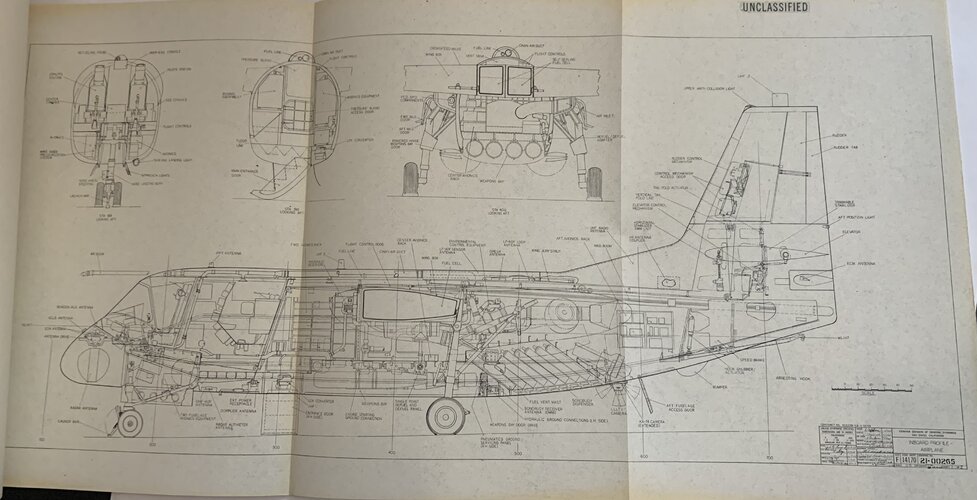 B3FCC3E0-222F-4C9E-A725-EB308695FC1A.jpeg1.8 MB · Views: 189
B3FCC3E0-222F-4C9E-A725-EB308695FC1A.jpeg1.8 MB · Views: 189 -
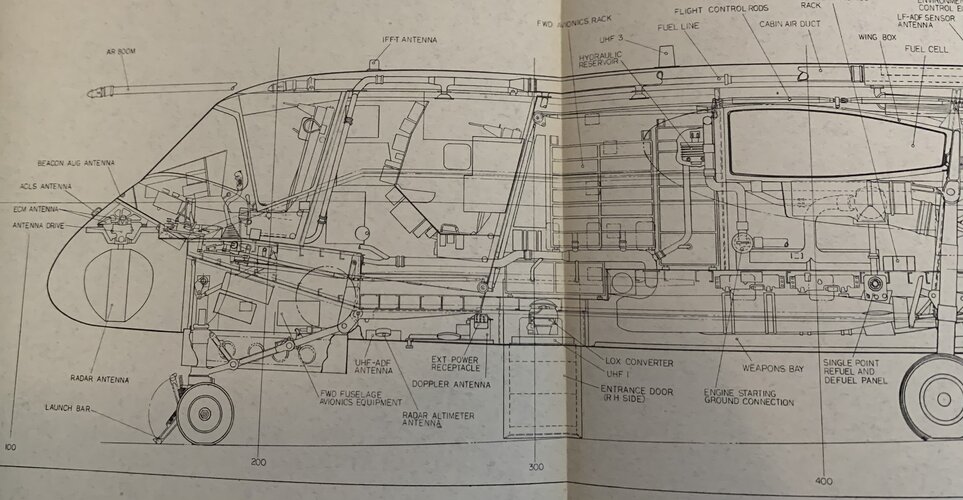 DC1BABB3-BB6A-4B2B-B7C7-5104A208D41C.jpeg1.7 MB · Views: 189
DC1BABB3-BB6A-4B2B-B7C7-5104A208D41C.jpeg1.7 MB · Views: 189 -
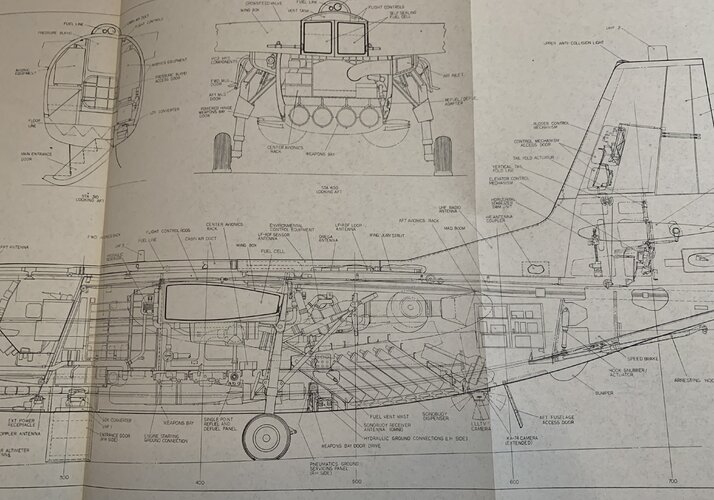 7F82193B-BE48-40CF-BD7C-9F5C0679C5B7.jpeg3 MB · Views: 198
7F82193B-BE48-40CF-BD7C-9F5C0679C5B7.jpeg3 MB · Views: 198 -
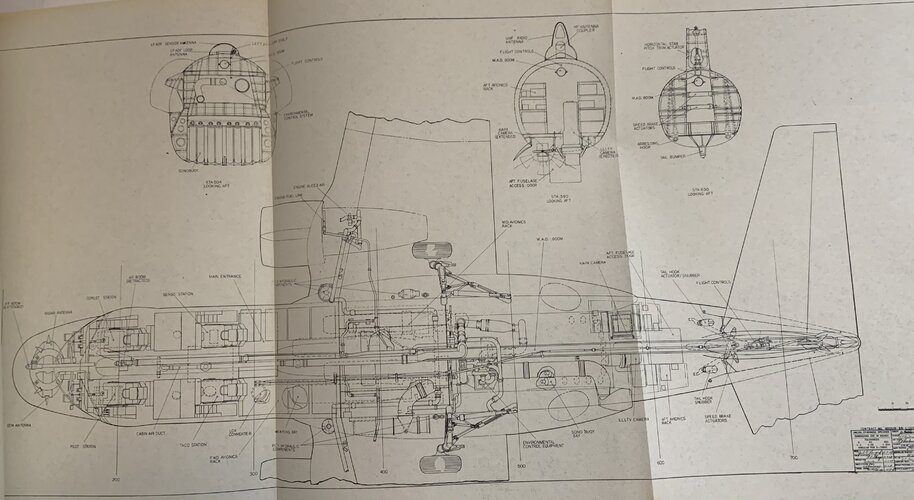 4CE5F1C8-BD49-435A-B03A-4B74948982C3.jpeg1.9 MB · Views: 179
4CE5F1C8-BD49-435A-B03A-4B74948982C3.jpeg1.9 MB · Views: 179 -
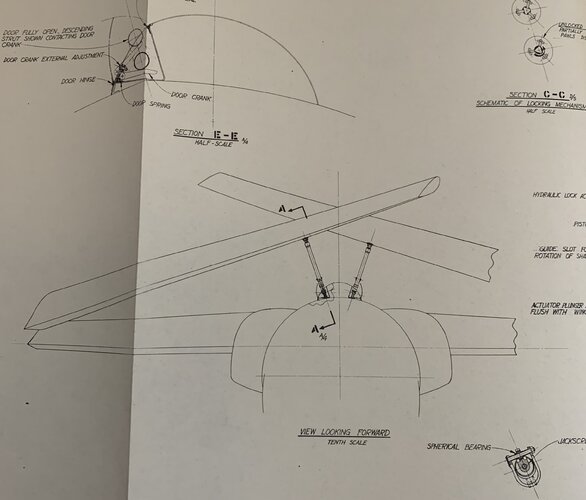 A3D4B9D8-B070-4530-AF61-10087FAE1424.jpeg1.3 MB · Views: 169
A3D4B9D8-B070-4530-AF61-10087FAE1424.jpeg1.3 MB · Views: 169 -
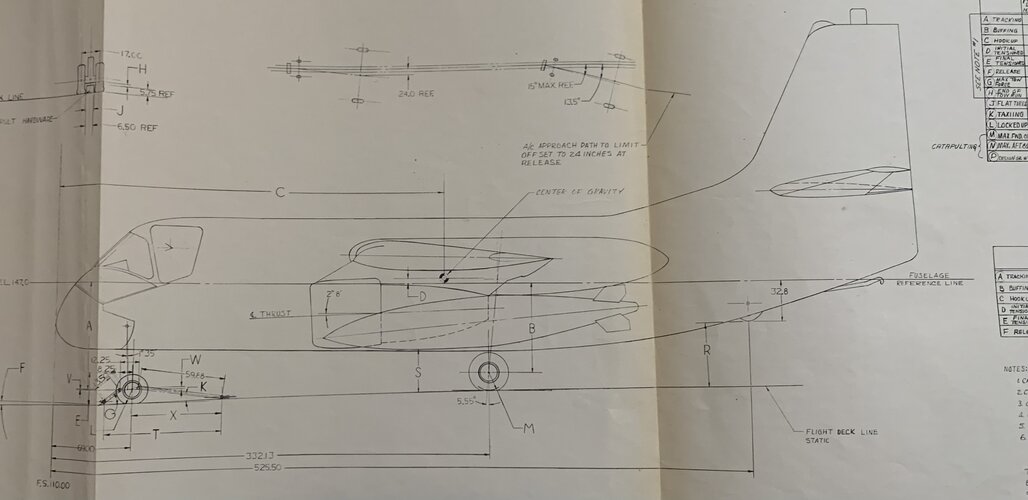 9EF4EA65-1102-4D56-BCFF-6C5A3AB771C4.jpeg1.1 MB · Views: 166
9EF4EA65-1102-4D56-BCFF-6C5A3AB771C4.jpeg1.1 MB · Views: 166 -
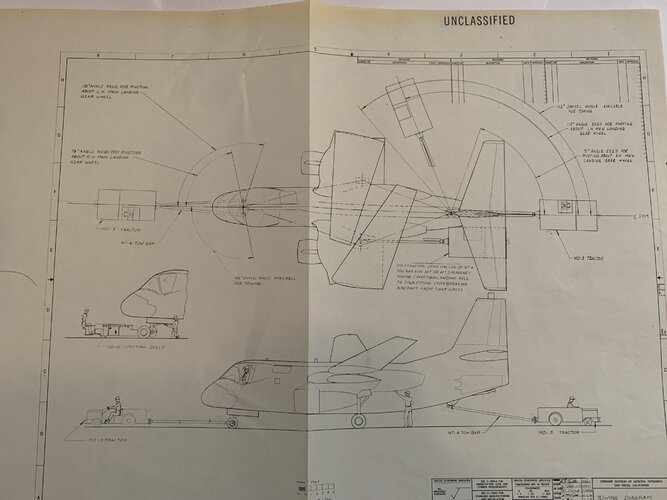 1A754343-32E0-4028-A6E3-8B58CD463784.jpeg2.2 MB · Views: 203
1A754343-32E0-4028-A6E3-8B58CD463784.jpeg2.2 MB · Views: 203 -
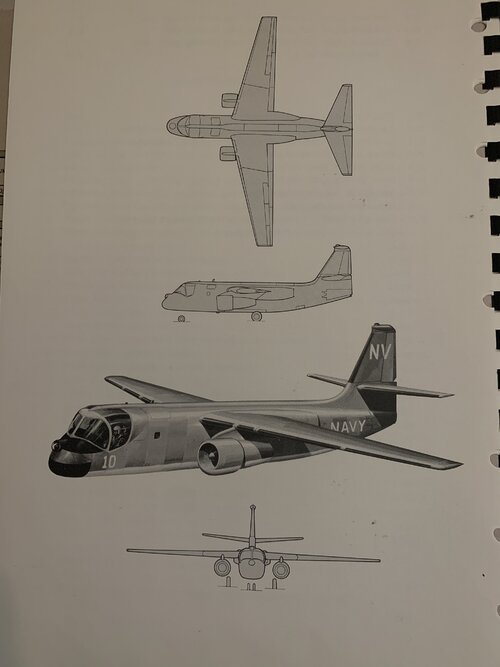 C6379CBD-5913-48B4-A273-261F3A1A8011.jpeg2.5 MB · Views: 204
C6379CBD-5913-48B4-A273-261F3A1A8011.jpeg2.5 MB · Views: 204 -
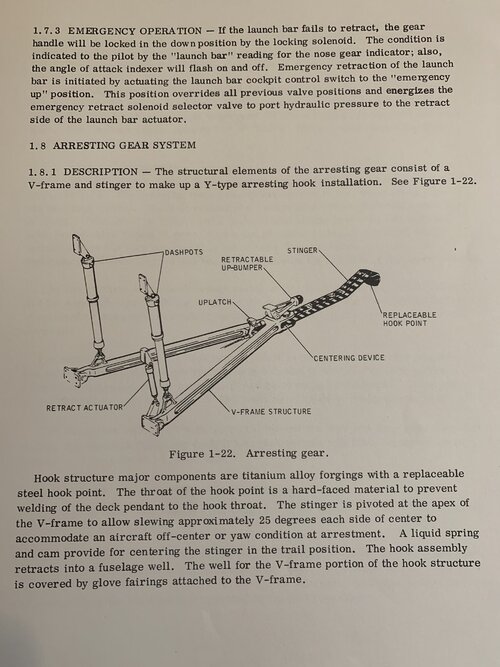 A9698D2E-53C5-4DFA-B683-AB12BED04C21.jpeg2.7 MB · Views: 195
A9698D2E-53C5-4DFA-B683-AB12BED04C21.jpeg2.7 MB · Views: 195 -
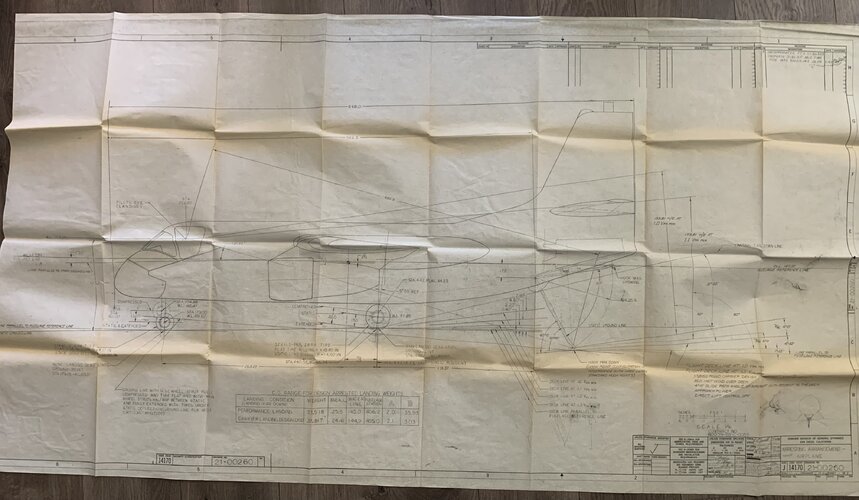 9CCB5708-211F-44BF-9BC7-EE2C5344D165.jpeg2 MB · Views: 153
9CCB5708-211F-44BF-9BC7-EE2C5344D165.jpeg2 MB · Views: 153 -
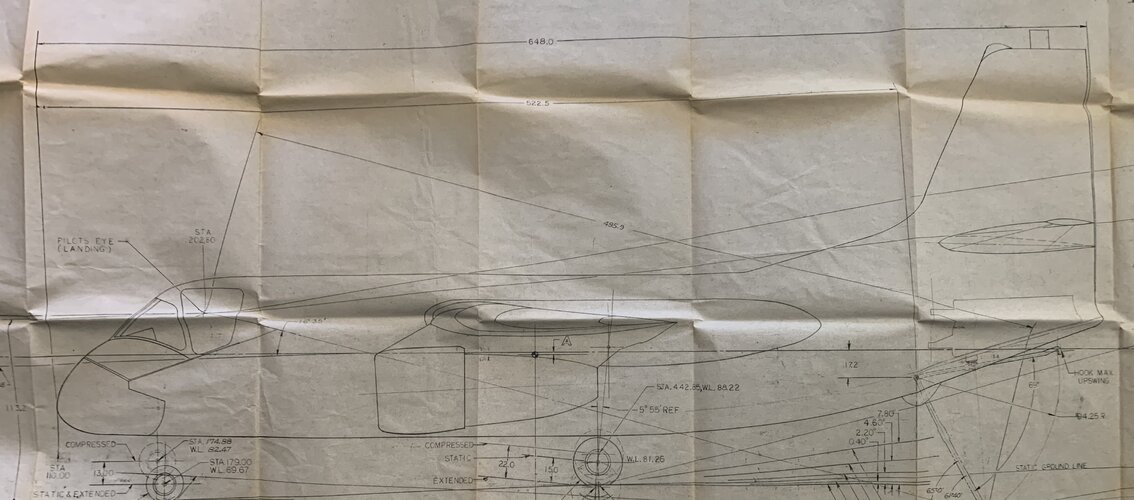 2612F6B1-C014-4BDE-B849-1E0CED32C077.jpeg1.8 MB · Views: 159
2612F6B1-C014-4BDE-B849-1E0CED32C077.jpeg1.8 MB · Views: 159 -
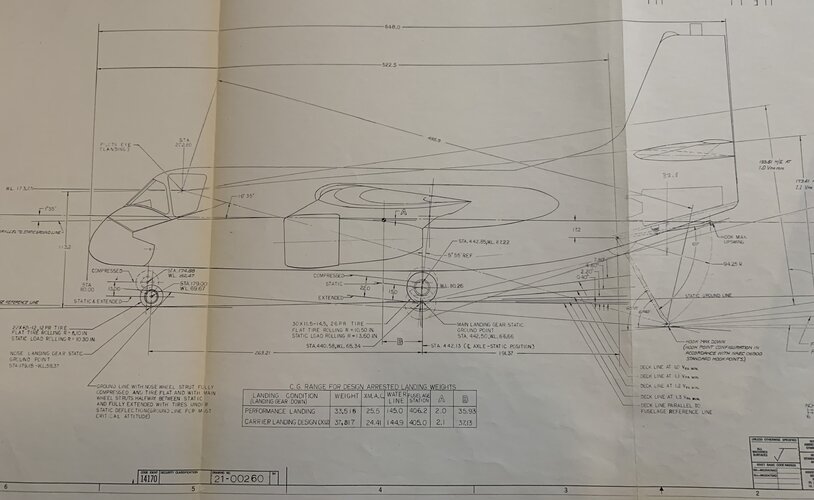 0C3EB2DE-6879-4936-A888-CE8B338F98F1.jpeg1.8 MB · Views: 214
0C3EB2DE-6879-4936-A888-CE8B338F98F1.jpeg1.8 MB · Views: 214
Similar threads
-
Lockheed S-3 Viking Variants and Projects
- Started by Abraham Gubler
- Replies: 102
-
Lockheed "Micro" S-3 Viking variant (US Navy "Type A" proposal)
- Started by nova10
- Replies: 15
-
VA (L) Competition - alternatives to the A-7
- Started by overscan (PaulMM)
- Replies: 66
-
Fleet Air Defense Fighter - Douglas F6D-1 Missileer and its rivals
- Started by Pioneer
- Replies: 149
-
VFAX (1974) / NACF Projects (Pre F/A-18 concepts)
- Started by overscan (PaulMM)
- Replies: 53

